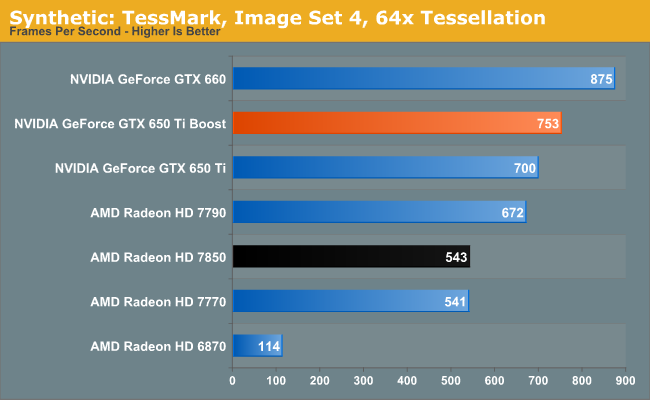NVIDIA GeForce GTX 650 Ti Boost Review: Bringing Balance To The Force
by Ryan Smith on March 26, 2013 8:00 AM ESTSynthetics
As always we’ll also take a quick look at synthetic performance to get a better look at our video cards' underpinnings. These tests are mostly for comparing cards from within a manufacturer, as opposed to directly comparing AMD and NVIDIA cards.
We’ll start with 3DMark Vantage’s Pixel Fill test, a mix of a ROP test and a bandwidth test to see if you have enough bandwidth to feed those ROPs.

3DMark Vantage’s pixel fill test confirms what we know from the specs of the GTX 650 Ti Boost: that it has received a massive boost in ROP performance and memory bandwidth. The 45% greater pixel throughput rate here doesn’t reach the kind of lofty goals that the theoreticals would put it at, but it’s clearly quite an improvement. Interestingly despite the equal ROP throughput and memory bandwidth of the GTX 660 and GTX 650 Ti Boost, the GTX 660 is still clearly in the lead here. We’ve never looked at the impact of GPCs here, so if our card is a 2 GPC model then this might explain what we’re seeing.
Moving on, we have our 3DMark Vantage texture fillrate test, which does for texels and texture mapping units what the previous test does for ROPs.

Texture fillrates on the other hand are really only benefitting from the higher clockspeeds of the GTX 650 Ti Boost over the GTX 650 Ti, and memory bandwidth to a much lesser extent. This is why despite the similarities between the GTX 650 Ti Boost and the GTX 660, the latter is still quite safe from the GTX 650 Ti Boost.
Finally we’ll take a quick look at tessellation performance with TessMark. We have everything turned up to maximum here, which means we're looking at roughly 11 million polygons per frame.

NVIDIA has always had a fairly ridiculous geometry throughput rate, and that doesn’t change on the GTX 650 Ti Boost. A score of 753 is second only to the GTX 660, and well ahead of the 7850, which is an interesting confluence of a 2 primative/clock rate, and its lower clockspeeds relative to the 7790 and GTX 650 Ti Boost.










78 Comments
View All Comments
Zstream - Tuesday, March 26, 2013 - link
Any specific reason as to why the 1gb wasn't used?Zstream - Tuesday, March 26, 2013 - link
In addition, the 7790 will have 2gb cards as well so I'm just confused overall.DanNeely - Tuesday, March 26, 2013 - link
Probably because nVidia only sent a 2GB sample. I assume once retail cards are available a 1GB model will be tested too.Oxford Guy - Tuesday, March 26, 2013 - link
Of course they didn't send the 1GB model. It's absolutely completely positively ridiculous. It has no business existing.shandy706 - Tuesday, March 26, 2013 - link
They say why in the article. I think I'd read it before commenting.lol
Zstream - Tuesday, March 26, 2013 - link
I guess I don't see where that's in the article. Can you comment on the paragraph?shandy706 - Tuesday, March 26, 2013 - link
"Please note that the GTX 650 Ti Boost NVIDIA is sampling is the 2GB card. We’ll take a look at 1GB cards later once those arrive, since they were a late addition."Second page, very middle.
HighTech4US - Tuesday, March 26, 2013 - link
From page 2 (clear as day, if you just bothered to read)Please note that the GTX 650 Ti Boost NVIDIA is sampling is the 2GB card. We’ll take a look at 1GB cards later once those arrive, since they were a late addition.
Zstream - Tuesday, March 26, 2013 - link
Thanks for clearing that up. I will have to wait to see if the 2gb is a paper launch.Ryan Smith - Tuesday, March 26, 2013 - link
2GB 650 TiB launches this week. It will be 1G that will come later.